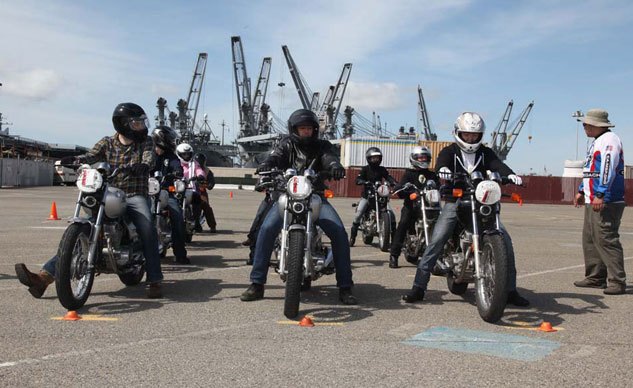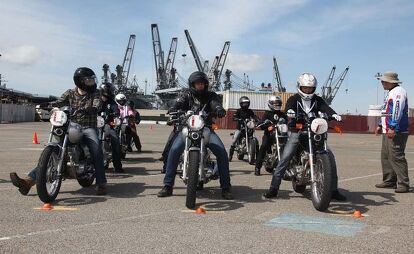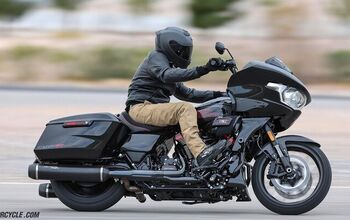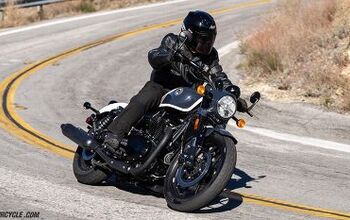Skidmarks – Motorcycle Safety Theater
“They pretend to pay us, and we pretend to work…”
– Punch line from an old joke in the former Soviet Union
Here’s the one thing you can count on if you’re a motorcycle-safety professional: your feet will hurt. I know I need to send away for some of those $300 custom-made insoles, but as long as it’s just me and Dr. Scholl standing in a parking lot for two 12-hour days in a row, by 3:00 pm Sunday my dogs are barking loud enough to prompt calls to Animal Control. Ow.
But of course, the joys of introducing a new crop of motorcyclists to our sport while showing them the basics of safe riding overcome those physical pains, right? The horrors of drinking McDonald’s coffee at 6:00 am, the wind, the rain, the cold, the scorching heat, the permanent sunburn on your face and neck fade to the back of your mind as you watch a line of riders slowly wobble towards you on their very first motorcycle ride.
In case you don’t know, in the vast majority of U.S. states, the Motorcycle Safety Foundation administers its venerable Basic RiderCourse (BRC) to teach prospective riders how to ride. This is a massive improvement over the previous system, which experts like to call “absolutely nothing at all.” Under that system, your dad, older brother, buddy or salesperson would “take you out back” and “show you a few things” to have you riding in no time. In many cases, the new rider would indeed pick up the basic controls and concepts and start riding in minutes. In fewer cases, the new rider would indeed be riding in no time. Riding right into a bush, right into a parked car, or right into a plate-glass window. Biologists call this natural selection.
After a giant surge in motorcycle ownership through the 1970s – quickly followed by a giant surge of motorcycles riding through plate-glass windows and shrubs – we got serious about rider training. USC researcher Harry Hurt‘s famed 1980 study found out many interesting things about motorcycle crashes. Tattooed and co-habitating riders, for instance, are over-represented in accidents, while salesmen and attorneys are (some would say unfortunately) under-represented. Riders were also more likely to crash heading home than to work, because, hey, nobody’s in a hurry to get to work.
The safety pros picked up on three main things from Hurt: helmets save lives, unlicensed riders are more likely to crash, and untrained riders are 92 percent of the injured and killed. Government and industry alike soon decided this called for an enormously complex national program, STAT!
By the end of the 1980s, there was an entire system of Motorcycle Safety Foundation-administered schools spread across this great land, and teaching newbies how to ride was its raison d’être.
The MSF’s curriculum applied modern principles of adult education to effectively and safely teach the general public. To encourage prospective riders (and customers for the membership of the MSF’s parent organization, the Motorcycle Industry Council) to take the class, many states provided a waiver to DMV skills testing – a neat solution that at once solved both the lack of formal training and the lack of proper licensing associated with higher crash rates.
Now, over 25 years later, many thousands – millions – of riders have spent a weekend on hot parking lots, learning the basics without performing glass-shattering scenes from The Benny Hill Show. In California, the great majority of riders now have the proper license – the opposite of what it was in 1980, when only a minority had proper motorcycle endorsements. For new riders seeking training, the mantra has changed from, “I’ll teach you how to ride – it’s easy” to “take the MSF class – it’s easy.” The three-headed Hydra related to the fatalities and injuries in the Hurt study – licensing, helmets, training – has been mostly subdued.
That should have fixed things. Except … it hasn’t.
That’s what’s frustrating to me as a RiderCoach – I may be flattening my arches for nothing. Thirty years along and the fatality rate stubbornly remains as high as ever. The number of annual fatalities fluctuates depending on economics, but it seems more closely tied to how many motorcycles are on the road, not to how much training riders get. Exactly 4,957 motorcyclists died in 2012. Even one is too many, obviously, but would it have been 14,000 without the MSF programs? Or would it have been lower if the motorcycle industry had stayed out of the training game? I don’t know. But I do know that the number of other automotive fatalities is dropping like an anvil in a Road Runner cartoon, and what will happen when motorcyclists are 50 percent of the roadway deaths when we’re only .5 percent of total roadway users? Do you think politicians will let us ride motorcycles anymore? Really?
Studies after Hurt don’t show a clear relation between safety and training, and the insurance industry is lukewarm about rider education, preferring statistically-probative helmet laws and ABS to reduce death and injury. If your insurance company offers a discount for completing an MSF class, (according to motorcycle insurance expert Mike Felder, few actually do) it’s often a surprisingly small amount.
I’ve been studying motorcycle safety for over a decade, and what I’ve learned is discouraging and maddeningly static. I’m burying this paragraph deep down here, as my own conclusions aren’t very popular around other motorcycle-industry folk: Motorcycles are horrifically, absurdly dangerous and probably shouldn’t be ridden by anybody, ever. I feel oogy recommending any uninformed person jump on a motorcycle or scooter and start riding, as it’s about 30 times more dangerous than driving a car. Thirty times! If Delta was 30 times more likely to crash than Southwest, it would have to sell tickets anonymously through StubHub or at least let you check a bag for free. And yet a half million motorcycles and scooters get snapped up in the U.S.A. every year even though riding one is about as dangerous a transportation choice you can make, short of walking drunk at night on a country road. If we were up front about those risks, would that impact sales? Maybe a little. Would it keep the people out who are likeliest to crash? Probably not.
When I talk to other RiderCoaches about the dismal state of motorcycle safety, the best argument they can come up with in favor of our current system is that it’s better than nothing. This is also a good argument for defending Taco Bell or marital sex. But I disagree – it is much better than nothing, if not ideal. If you’re a fast learner and have reasonable coordination and balance, you can learn to ride in a weekend and even pick up habits that may keep you alive. For the low (or free in some places) tuition, it’s a screaming deal. Most of the RiderCoaches I know do it because they enjoy working with motorcycles and the people who ride them, not because they are idealists who believe in the system. I’m no different.
What may surprise you is who is taking this class. The last time I taught – weekend before last – more than half of my 22 students already knew how to ride, often taking the course because they had bought a bike they thought was too big for the DMV skills test. That’s common – in my experience with about 2,000 students over the last five years, two thirds of them already knew how to ride, or learned so easily they hardly needed the class. Another 20 percent learned reasonably well, and the remainder … well, they almost always pass the “skills evaluation” at the end of the weekend, but look out for those plate-glass windows. If it were me, I’d make the test harder – at least as hard as the DMV “lollypop” test – with no retest available if the student fails. They can retake the class, or they can go practice with a permit, but there’s no reason to give low-skilled riders a full motorcycle license endorsement. None.
My experience working for two years to found an independent basic-motorcycle-skills school revealed those challenged students – the ones with less innate ability, that learn slower than the rest of the class – usually don’t do much riding after they pass. They usually complete the MSF BRC, and get their license endorsement, but they usually don’t wind up owning or riding a motorcycle. But maybe that’s the mad genius of the MSF – they are (rightfully) frightened and intimidated by the noise, heat and violent movement of motorcycles and after they’ve proved to themselves they can do it, forget their dreams of ridin’ on a desert highway, long blond hair flyin’ in the wind. Forty years ago, those folks would have bought the motorcycle first and then possibly hurt or killed themselves learning that motorcycling wasn’t for them.
So we have a student body of mostly skilled and experienced riders taught by a corps of instructors who may or may not feel they’re fixing the problem of too many dead and injured riders. RiderCoaches there for the paycheck and satisfaction of being professionals who do their jobs well teaching motorcyclists there to take advantage of a loophole to easily get their license. And yet, this Saturday, thousands of men and women will head down to the ranges where they work, put on silly looking sunhats and sunscreen and start plopping cones down in familiar patterns. The student parking will fill up with minivans, pickups and (yes) motorcycles, and we’ll all dance the dance.
It’s fun, worthwhile and looks good – just like a well-executed Broadway show. Motorcycle Safety Theater. Is it really the best we can do?
Aside: Fantastic Photos
I selected these photos because I’m so proud of working with my regular photographer, Bob Stokstad. He’s photographed dozens of motorcycles with me since 2005 (when I started at Motorcycle.com), but he’s also talented as a photojournalist, nature and portrait photographer.
A few years ago I needed something to illustrate a story from David Hough about safety training. I knew Bob’s photos would catch the carefully choreographed dance of students and RiderCoaches much better than my writing, so in March of 2011, I asked him to photograph an MSF BRC at the decommissioned Alameda Naval Air Station, not far from San Francisco. Yes, that’s the historic USS Hornet in the background. In the photos, RiderCoaches Rob Kong and Heidi Burbank show how they are hardworking pros who really enjoy “coaching,” as RiderCoaches call instructing.
Check out more of Bob’s portfolio, including vintage motorcycle shows, Supermoto and Flat Track racing and his trip to the South Pole as a physicist (!) at his website. Thanks for all your hard work, Bob! I would still just be another jackass posting on the MO discussion forums without you.
Gabe Ets-Hokin is a senior partner in the firm of Eeny, Meeny, Miney and Moe, specializing in legislative solutions to non-existent problems. He’s best known for writing “Frankie’s Law,” legislation in 34 states and the District of Columbia which bans dog walking in enclosed parking garages while using Robitussin DM and listening to a “This American Life” podcast on even-numbered Saturdays.
More by Gabe Ets-Hokin









































Comments
Join the conversation
It could be that another part of the problem is that the riders who could benefit the most from the course never attend because they already think they have it all figured out. I'm pretty sure the risk takers you see doing wheelies on the interstate at 80+ mph never stopped to think that the safety course could help them become a better rider.
I totally disagree with this statement, "I feel oogy recommending any uninformed person jump on a motorcycle or
scooter and start riding, as it’s about 30 times more dangerous than
driving a car."
Maybe in California we're that "safe," but in 99% of the country, motorcycles wouldn't make up 0.5% of road traffic on a perfect summer day. We're a lot closer to 0.001% than 0.5%, which means it is more like 14,000X as dangerous to be on a motorcycle than in a cage. (Simply divide our usual 14% of fatalities by our traffic contribution to derive what our fatalities should be vs what they are.)
The current tests are a joke. Motorcycling is at least as dangerous as skydiving, scuba, hanggliding, or flying a plane, but the complexity and detail of our license testing is a tiny fraction of even unregulated sports activities. Like you suggest, there is no future in continuing to be a massive portion of road fatalities when all other vehicles are getting safer.